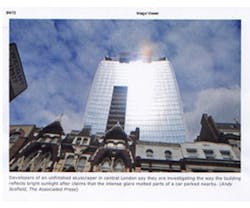A recent Associated Press caption reported: “Tower’s sun glare burns Jaguar, spurs hunt for solution.”
There have been many reports of glare on newly constructed roofs that have required remediation, but in this case the heat source was from reflective window glass, not just from white or aluminum roof coatings on a roof surface.
What makes this incident special is the magnitude of the heat load. The article went on to state that a Jaguar parked in London in the path of the reflected heat “for a couple of hours” had melted the Jaguar’s mirror, panels, and hood ornament and burned a hole in the welcome mat of a barbershop across the street.
That excessive heat load is an entirely new issue – not just for luxury cars parked near highly reflective facades, but for roofs too, as too much heat causes premature aging.
What the Standards Say
Richard (Dick) L. Fricklas was technical director emeritus of the Roofing Industry Educational Institute prior to his retirement. He is co-author of The Manual of Low Slope Roofing Systems, and continues to participate in seminars for the University of Wisconsin and RCI Inc., the Institute of Roofing, Waterproofing, and Building Envelope Professionals. His honors include the Outstanding Educator Award from RCI, William C. Cullen Award and Walter C. Voss Award from ASTM, the J. A. Piper Award from NRCA, and the James Q. McCawley Award from the MRCA. Dick holds honorary memberships in both ASTM and RCI Inc.
ASTM Specification for Poly (Vinyl Chloride) Sheet Roofing (D4434) requires heat aging at 176 degrees F. for 56 days. This roughly relates to chemical kinetics that states once material has reached its energy of activation, the rate of acceleration doubles for every rise of 10 degrees C. Standard D6754 for Ketone Ethylene Ester (KEE) also uses 176 degrees F. for 56 days.Heat aging for Thermoplastic Polyolefin Based Sheet Roofing (TPO) D6678 is somewhat more severe – 240 degrees F. for 224 days, perhaps recognizing the demand for more efficient roofing systems and as a result of far more thermal insulation directly under the roof membrane.
All of the above polymers are designated as “thermoplastic,” and their seams can be heat welded using a hot-air welding gun. The heat exposure is very brief whether hand-welded or machine-welded. Many of these materials can now be seamed using pressure-sensitive cold adhesives. However, we lack accurate data on reflected heat. If the London building (which will not be completed until 2014) is any indication, we need to use materials that can accommodate these new magnitudes of heat load.PageBreak
Options for Roof Protection
We also need to take a serious look at roof insulation for heat resistance. Polystyrene foam softens and distorts at temperatures around 140 degrees F. Single-ply vendors recommend that if dark-colored membranes such as EPDM will be used on the roof, the membranes should be rapidly surfaced (i.e. same day) with ballast so the temperature won’t climb too high. Alternatively, you can also use a cover board placed between the membrane and thermal insulation.
There are other possibilities: we could use protected membrane systems (PMR), pairing latex-treated cement mortar with interlocking side laps, pavers, or even heavily ballasted roofs when there is a danger of facing such heat loads. Where we currently use membrane materials for vertical flashings, we may have to switch to coated metal flashings not only for counter-flashing but base flashings as well.
Still another issue: Suppose your roof is doing just fine, thank you, but then a new building is constructed across the street. With PV panels, there already is some protocol over access to sunlight. In the case of this recent London episode, who is expected to anticipate these incredible temperatures? Water boils at 212 degrees F., but based upon the AP report, these temperatures are far hotter than that.
How does the designer of a new, reflective building anticipate the effect and influence on surrounding buildings?
How does the warrantor of your existing building deal with a sudden change in heat load, with flashings that are melting, membranes that are slipping, lap sealants that are failing, and thermal insulations that are seeing cellular foam collapse?
Isaac Newton appears to have been right again: "To every action there is always opposed an equal reaction."
Take Control of Roofing
Top roofing resources.
Greener than Green
Maxed out on insulation savings? Consider these other energy-saving roofing strategies.
5 Strategies for Managing an Aging Roof Portfolio
Evaluate staff, funding, and physical conditions to create an action plan for your roofs.
About the Author
Richard L. Fricklas
Richard (Dick) L. Fricklas received a Lifetime Achievement Award and fellowship from RCI in 2014 in recognition of his contributions to educating three generations of roofing professionals. A researcher, author, journalist, and educator, Fricklas retired as technical director emeritus of the Roofing Industry Educational Institute in 1996. He is co-author of The Manual of Low Slope Roofing Systems (now in its fourth edition) and taught roofing seminars at the University of Wisconsin, in addition to helping develop RCI curricula. His honors include the Outstanding Educator Award from RCI, William C. Cullen Award and Walter C. Voss Award from ASTM, the J. A. Piper Award from NRCA, and the James Q. McCawley Award from the MRCA. Dick holds honorary memberships in both ASTM and RCI Inc.

